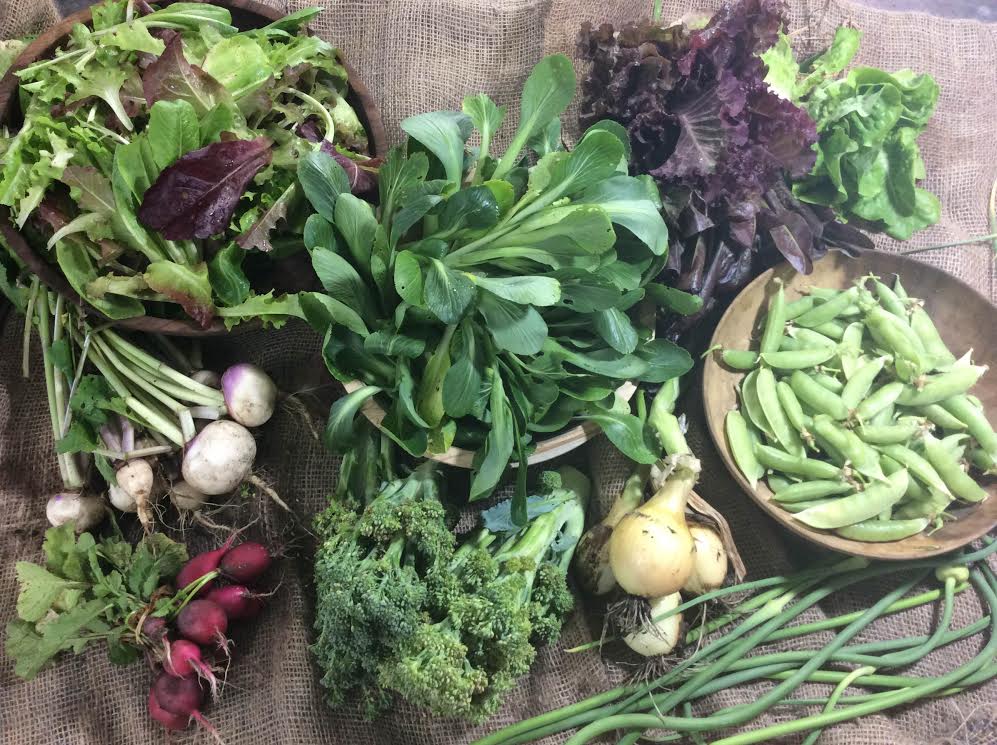Week 1 of the 2015 CSA season is finally here!! Enjoy the fresh salad greens and crisp sugar snap peas and radishes that come with the early summer! The vegetables that will be included in each CSA share, are (clockwise beginning in the upper left corner of the photo): Baby cut Salad Greens, Bok Choy, Head Lettuces, Sugar Snap Peas, Garlic Scapes, Fresh Candy Onions, Broccoli, Radishes and Turnips with greens.
Here are some storage and using/ cooking instructions for each item. All of the items in the CSA week 1 box should be stored in the refrigerator. The lettuce, baby salad mix, and bok choy can be pre-washed, spun dry in a salad spinner and put in a plastic bag layered with some paper towels to absorb extra moisture. It is important that the greens are not stored wet.
Lettuce and baby cut salad greens: Store in plastic bag in refrigerator. Baby cut salad greens should be used first. Salads, Salads, Salads!! Need some new ideas for salad toppings? Look at this: Chart of Salad Toppings Combinations for inspiration. Use as “wraps” for Asian chicken lettuce wraps. If you have never tried lettuce, barely cooked, try these: Wilted lettuce salad or Grilled Romaine Salad.
Baby Bok Choy: Store in plastic bag in the refrigerator. Here is a basic bok choy recipe with great instructions: Stir-fried Bok Choy. If you would rather eat bok choy raw; it can be chopped and dressed with an asian- style dressing: Bok Choy Salad
Sugar Snap Peas: Store in plastic bag in the refrigerator. Peel off the strings on the sugar snap peas. Sugar snap peas are good raw or barely cooked. Try Stir-fried Sugar Snap Peas or Sugar Snap Peas with orange-ginger dressing.
Onions: These are fresh, uncured onions, which may be stored in the refrigerator. They should be used within 2 weeks.
Radishes: Store in plastic bag in refrigerator. Crisp radishes in ice water. Sliced radishes add great flavor to salads. You can also just eat them straight with butter and a sprinkle of salt. There are many variations of radish salads, here are a couple: Radish and Mint Salad , Smitten Kitchen’s chopped salad, and Radish, Cucumber and Orange Salad.
Garlic Scapes: can be used just like garlic in recipes. They are very versatile. On thicker scapes, snap off the woody end (in the same way you would snap asparagus). Try them in a sauté, roasted, pickled, added to soups, and more. The most tender tops of the stem and the buds are delicious chopped up raw.
A site highlighting many ways to serve garlic scapes; including a garlic scape pesto recipe: What to do with Garlic Scapes (Note: my family made the Garlic Scape Pesto from this link, using sunflower seeds instead of pine nuts, and it was wonderful!).
Garlic Scape and White Bean Hummus
1/3 cup sliced scapes
1 T lemon juice
1/2 tsp sea salt
ground black pepper
1 can (15 oz.) cannelloni beans, rinsed and drained
1/4 cup olive oil
In a food processor, process scapes with lemon juice, salt and pepper until finely chopped. Add beans and process to a rough puree. With motor running, slowly drizzle olive oil through feed tube and process until fairly smooth. Pulse in 2 or 3 T water, or more, until mixture is the consistency of a dip.
Broccoli: Store in a loose plastic bag in the refrigerator. Peeling the stems with a pairing knife is a great way to make the stems more tender. Here’s a couple of recipe ideas: Broccoli Salad and Roasted Broccoli
Turnips: Store in plastic bag in the refrigerator. Small turnips (size of golf balls or smaller) do not need to be peeled. Larger turnips can be easily peeled: slice off the top and bottom and use a paring knife to peel off the tough outer skin from top to bottom. Turnips can be sliced and eaten raw (they are spicy) or are cooked to mellow their bite. Here are some turnip recipe ideas: Kashmiri style kidney beans with turnips and Braised turnips with onions and carrots.

